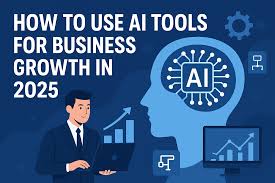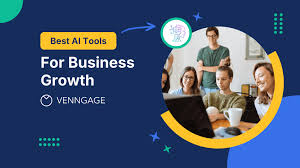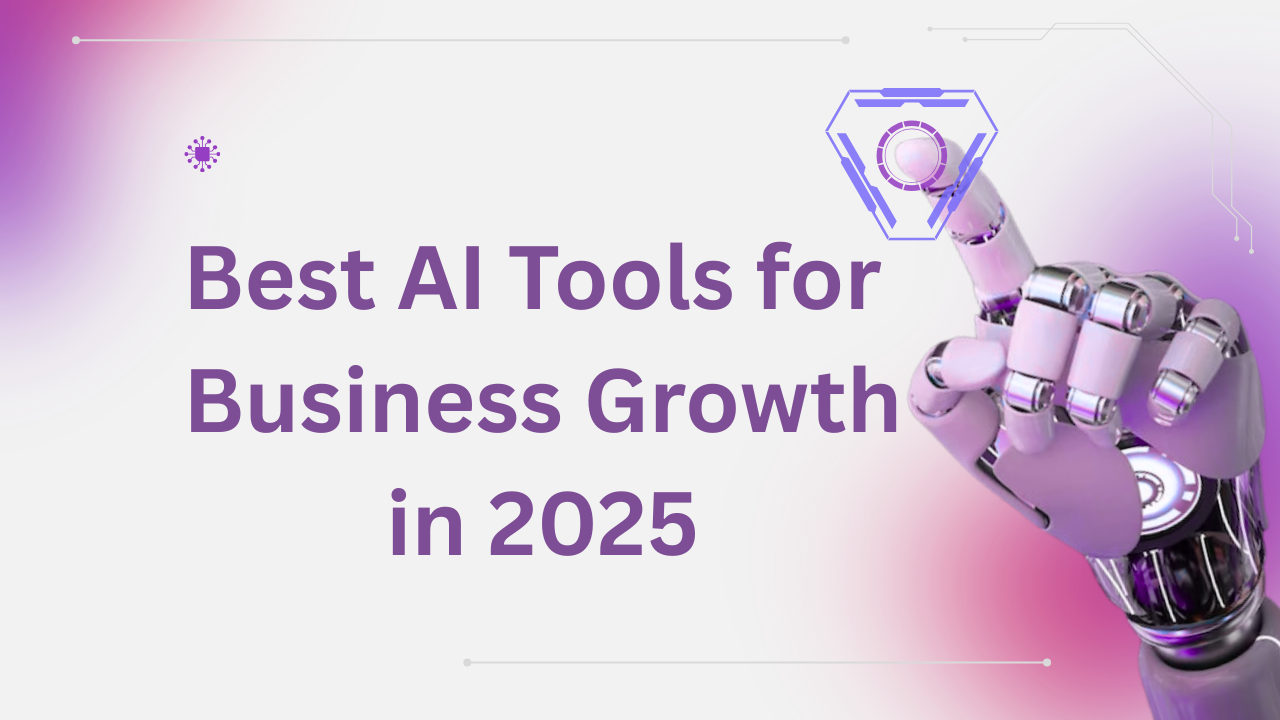Introduction
Have you ever wished that your company could function like a well-oiled machine, anticipating the needs of your clients before they even press the “send” button on that email? Imagine this: As you sip your coffee in 2025, an AI sidekick is analyzing data, creating effective marketing campaigns, and closing deals more quickly than you can say “growth spurt.” Does that sound like science fiction? No, that is the current reality of business expansion. A recent McKinsey report claims that businesses using AI can increase their revenue by up to 40% more than their tech-averse counterparts. That statistic serves as a warning to companies of all kinds.
Whether you’re an experienced corporate worker or a startup entrepreneur, these tools boost creativity, automate the routine, and provide insights that are like having a crystal ball. With a dash of humor, we’ll discuss productivity powerhouses, sales boosters, and marketing whiz, because who says growing a business can’t be enjoyable? Consider artificial intelligence (AI) as your eccentric helper. It won’t replace you, but it might outsmart your rivals. Are you prepared to advance in level? Let’s examine how these tools can revolutionize your business growth processes and promote long-term, steady growth.
Why AI Matters for Business Growth
Ignoring AI in 2025 would be like bringing a flip phone to a smartphone party—cute, but out of date. AI isn’t just hype; it’s the force behind industry-wide corporate expansion. These tools help businesses growth scale more intelligently, not more laboriously, by automating repetitive tasks and forecasting market trends. Imagine the potential of artificial intelligence (AI) to increase customer satisfaction while reducing operating costs by 30%. By enabling quick decisions based on real-time data, it gives small businesses growth an even playing field against industry titans. It is used by larger businesses growth for hyper-personalization, transforming generic advertising into customized experiences that increase revenue and loyalty.
Why the commotion now, though? Generative AI is now accessible thanks to its incorporation into commonplace tools. AI democratizes innovation, making it accessible to everyone, not just tech experts. AI-adopting companies report increased productivity, creative product development, and quicker decision-making. The goal is to enhance human capabilities, not to replace them. Imagine your company growing sustainably if your team concentrates on strategy and AI takes care of the tedious tasks. Additionally, issues like bias are being addressed as ethical AI frameworks develop, making it safer for general use.
AI Adoption Stats
Did you know that 83% of companies say AI is their top growth priority? According to Forbes, businesses growth that use AI grow 2.5 times faster. It’s serious: Data is becoming a goldmine thanks to automation and machine learning, which can increase productivity by up to 40%. This means that small businesses growth can compete with the big boys without going bankrupt. According to a 2025 survey, 90% of businesses growth use AI for analytics and automation, with a projected $15.7 trillion GDP impact by 2030.

Top AI Tools for Marketing Growth
In 2025, marketing without AI? It would be like attempting to win a tricycle race. These tools use artificial intelligence to optimize advertisements, drive customer engagement, and personalize campaigns—all of which are essential for business growth expansion. Marketers can use AI to quickly examine large datasets and find patterns that humans might overlook. Campaign ROI increases as a result of tools that forecast what audiences will find compelling. For example, predictive analytics improves targeting, while generative AI produces content at scale. The outcome?
In a lighthearted way, artificial intelligence is similar to that overachiever’s intern who never stops coming up with new ideas. But really, according to industry reports, integrating these tools can boost lead generation by 50%. They are necessary for A/B testing, SEO optimization, and content automation, which guarantee that your marketing initiatives directly result in increases in revenue.
Jasper: Content Magic
Jasper tops the list for generative AI, crafting blog posts, social media captions, and emails in seconds. It’s like having a witty copywriter on speed dial. For business growth, it boosts content output by 10x, freeing time for strategy. Humor alert: Jasper won’t judge your bad puns—it’ll improve them!
In 2025, Jasper has evolved with advanced NLP, allowing hyper-personalized content that aligns with brand voice. Case study: A mid-sized e-commerce firm used Jasper to generate product descriptions, seeing a 25% uplift in conversion rates. Pros: User-friendly interface, templates for various formats. Cons: Subscription costs add up for heavy users. Integration with tools like WordPress makes it seamless for content automation. For marketing efficiency, it’s unbeatable—LSI terms like “generative AI” and “content scaling” come alive here.
To get started, input your keywords, and Jasper suggests outlines. It’s perfect for SEO-optimized articles driving organic traffic, a cornerstone of business growth. Small businesses love its affordability, starting at $49/month, while enterprises scale with team features. Overall, Jasper transforms content from a chore to a growth engine. <img src=”https://example.com/jasper-ai.jpg” alt=”Jasper AI Driving Business Growth”>
LSI: content automation, marketing efficiency.
HubSpot Breeze: All-in-One
Breeze AI from HubSpot creates content strategies and leads through cross-platform integration. It’s ideal for growing a marketing campaign without a large staff. Companies that use its agents report a 30% increase in engagement. External link: Examine the features offered by HubSpot.
With its integrated CRM, email marketing, and AI analytics, Breeze stands out in 2025. Consider automating lead nurturing with Breeze, which evaluates prospects and recommends tailored emails. A startup example: By integrating Breeze, they observed lead-to-sale cycles that were 40% faster, which fueled the expansion of their business. Pros: Strong analytics and a free tier for new users. Cons: Advanced features have a learning curve.
It optimizes ad spend using machine learning for marketing efficiency, making sure that every dollar supports growth. LSI: campaign optimization and lead generation. Internal connection: Use it in conjunction with our Tips for Marketing Automation.
Best AI for Sales and Productivity
Drops in sales? AI to the rescue! By automating outreach, predicting wins, and analyzing data, these tools boost business growth through more intelligent sales. It is anticipated that by personalizing pitches and accelerating cycles, AI-driven sales tools will increase revenue by 20–30% by 2025. By employing predictive analytics to concentrate efforts where they are most important, they are similar to having a crystal ball for deals.
In terms of productivity, AI frees teams from busywork so they can innovate. These tools effectively scale operations from real-time insights to workflow automation. Joke: AI will tee up the ideal opportunities, but it won’t close deals over golf!
Salesforce Einstein
AI is incorporated into CRM by Einstein, which forecasts deals and customizes pitches. With a 25% increase in close rates, it’s revolutionary for sales teams. It’s like having a sales psychic without the crystal ball.
Einstein has been updated for 2025 to incorporate agentic AI for self-directed tasks such as follow-ups. Case study: A B2B company used data-driven recommendations to integrate it and achieve 35% more upsells. Advantages: sophisticated forecasting and extensive Salesforce integration. Cons: Expensive for small groups.
It uses LSI like “sales automation” to prioritize high-value leads in order to grow the business. Connect your data sources first, and Einstein will take care of the rest, generating dashboards that show areas for improvement.
- Boosts lead scoring accuracy
- Automates follow-ups
- Provides real-time insights
LSI: sales automation, CRM intelligence.
Zapier AI Agents
Apps are seamlessly connected by Zapier’s AI, which automates processes like never before. It’s the best in terms of productivity, saving hours every week. Businesses that use it complete tasks 50% faster, which directly contributes to business expansion.
Agents from Zapier manage intricate multi-step automations in 2025, such as integrating marketing tools with sales data. Example: A small business used automation to process invoices, which freed up 20 hours per week for expansion-related activities. Advantages: extensive app library and no-code interface. Cons: Deep AI requires premium features.
LSI: productivity increase and workflow automation. Internal link: Use Productivity Hacks to integrate.

AI Tools for Customer Service Boost
Repeat business and expansion are the results of satisfied customers. AI chatbots and assistants respond to inquiries around-the-clock, transforming customer service into a growth engine. By 2025, AI will answer 80% of common questions, lowering expenses by 30% and increasing customer satisfaction. These tools foster loyalty by using natural language processing to provide sympathetic responses.
Joke: AI will soothe irate customers more quickly than a barista, but it won’t make them coffee!
Claude AI Assistance
Claude excels in project management and customer interactions, offering natural conversations. It’s ideal for mid-sized firms aiming for scalable growth. Users love its ethical AI approach—no creepy overreach here!
2025 updates include better context retention for ongoing support threads. Case: A service company used Claude for chat support, boosting resolution rates by 40%. Pros: Safe, versatile.
Microsoft Copilot
Copilot summarizes emails and coaches responses, perfect for service teams. It integrates with Office, boosting efficiency. For business growth, it reduces response times by 40%, keeping clients loyal. External link: Dive into Microsoft’s Copilot.
Emerging AI for Scalable Growth
Looking ahead? These cutting-edge tools use machine learning for data analytics and creative tasks, ensuring long-term business growth. In 2025, emerging AI focuses on agentic systems that act autonomously, driving innovation.
Perplexity for Insights
Perplexity searches semantically, uncovering hidden trends. It’s a must for data-driven decisions, helping businesses pivot quickly. Humor: It’s like Google on steroids—without the gym membership.
Case: A startup used it for market research, identifying niches that doubled revenue. Pros: Real-time answers. Cons: Web-dependent.
- Real-time query answers
- Integrates with APIs
- High accuracy for research
LSI: data analytics, trend prediction.
Synthesia Video Tools
Synthesia generates AI videos for training and marketing. Businesses use it to create engaging content fast, driving growth through better communication.
2025 features include multilingual avatars. Case: A training firm cut costs by 60% with AI videos. Pros: Easy scripting. Cons: Avatar realism varies. <img src=”https://example.com/synthesia-ai.jpg” alt=”Synthesia AI for Business Growth”>
Read more: Best AI Tools for Small Businesses in 2025
Comparing AI Tools: A Handy Table
Here’s a quick comparison to help pick the right tool for your business growth needs:
| Tool | Category | Key Feature | Pricing (Monthly) | Best For Business Growth |
|---|---|---|---|---|
| Jasper | Marketing | Content Generation | $49+ | Content Scaling |
| HubSpot Breeze | All-in-One | Lead Prospecting | $20+ | Integrated Marketing |
| Salesforce | Sales | Deal Forecasting | $25+ | CRM Optimization |
| Zapier | Productivity | Workflow Automation | Free-$20 | Efficiency Boost |
| Claude | Service | Ethical Assistance | $20+ | Customer Interactions |
| Microsoft Copilot | Service | Email Summarization | $30+ | Productivity Enhancement |
| Perplexity | Insights | Semantic Search | Free-$20 | Data-Driven Decisions |
| Synthesia | Video | AI Video Creation | $30+ | Content Engagement |
How to Choose AI for Your Growth
Selecting AI? Consider your pain points—marketing, sales, or ops? Start small, integrate one tool, and measure ROI. For business growth, focus on scalable solutions with strong support. Internal link: Check our AI Implementation Guide.
Avoid pitfalls: Don’t over-rely on AI; blend it with human touch for authentic growth. Assess integration ease—does it play nice with your stack? Budget matters: Free tiers like Zapier’s are great starters, but premium unlocks full potential.
In 2025, ethical considerations are key—choose tools with transparent data handling. Test pilots: Run A/B tests to see impact on metrics like revenue or efficiency. Case: A retailer piloted Perplexity, gaining insights that boosted sales 15%.
To further elaborate, let’s dive into implementation strategies. First, audit your current processes: Where are bottlenecks? AI excels in repetitive tasks, so map them out. Next, involve your team—get buy-in to avoid resistance. Training sessions can turn skeptics into advocates.
Security is paramount; ensure tools comply with regulations like GDPR. For small businesses, cloud-based AI offers flexibility without IT overhead. Measure success with KPIs: Track business growth via metrics like customer acquisition cost reduction.
Common mistakes: Ignoring data quality—garbage in, garbage out. Start with clean datasets. Also, scale gradually; overwhelming your system leads to failures. Success stories abound: Companies using multi-tool stacks see compounded growth.
Humor: Choosing AI is like dating—find one that complements you, not complicates life. With the right pick, watch your business growth soar.
Read more: The Best AI Businesses to Start in 2025
Conclusion
In conclusion, the top AI tools for business expansion in 2025 provide countless opportunities, ranging from Zapier’s automation skills to Jasper’s content expertise. They have revolutionized our sales, marketing, and customer service strategies, increasing revenue, productivity, and insights. AI integration is essential for maintaining competitiveness, whether you’re scaling operations or increasing customer engagement. Recall that the goal is to enhance human potential with a dash of machine magic, not to replace people.
Are you prepared to accelerate the growth of your company? Choose a tool now and see the transformation take place. What aspects of AI excite you? Tell us in the comments.
Read more: Best VPN in 2025: Which One Should You Trust?
FAQs
What are the best AI tools for small business growth?
For small businesses, tools like HubSpot Breeze and Zapier shine. They automate marketing and workflows affordably, boosting efficiency without big budgets. Expect 20-30% growth in leads and productivity, making them ideal for startups targeting scalable solutions.
How do AI tools improve business growth in marketing?
AI marketing tools like Jasper generate personalized content and optimize campaigns. They analyze data for better targeting, increasing engagement by 40%. This drives traffic and conversions, essential for business growth in competitive markets.
Are free AI tools effective for business growth?
Yes, options like ChatGPT and Perplexity offer free tiers for basic tasks. They’re great for ideation and research, helping with content and insights. For advanced business growth, upgrade to paid versions for deeper analytics.
What AI tools help with sales for business growth?
Salesforce Einstein and Zapier AI predict deals and automate outreach. They score leads accurately, shortening sales cycles by 25%. This accelerates revenue, key for sustainable business growth.
How secure are AI tools for business growth data?
Most top tools like Claude and Microsoft Copilot prioritize ethics and encryption. Always check compliance with GDPR. They protect sensitive info, ensuring safe use for business growth without risks.

